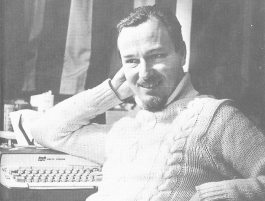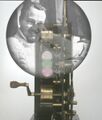John Brunner (nonfiction): Difference between revisions
No edit summary |
No edit summary |
||
| Line 53: | Line 53: | ||
* [[John Brunner]] | * [[John Brunner]] | ||
* ''[[Stand on FBI Headquarters]]'' | * ''[[Stand on FBI Headquarters]]'' | ||
* [[The Shockwave Rider (nonfiction)]] | |||
== Nonfiction cross-reference == | == Nonfiction cross-reference == | ||
Latest revision as of 07:49, 12 September 2022
John Kilian Houston Brunner (24 September 1934 – 26 August 1995) was a British author of science fiction novels and stories.
His 1968 novel Stand on Zanzibar, about an overpopulated world, won the 1969 Hugo Award for best science fiction novel, and the BSFA award the same year.
In the News
Crime fighter John Brunner uses Gnomon algorithm techniques to detect and expose crimes against mathematical constants.
Marshall McLuhan declines all invitations to form crime-fighting teams, says he prefers academic life.
Excerpts
Shalmaneser on sentience and God
A few days after they rigged up the direct-verbal inputs — Shalmaneser was the first computer ever with sufficient spare capacity to handle normal spoken English regardless of the speaker's tone of voice — one of the technicians asked him on the spur of the moment, "Shal, what's your view? Are you or aren't you a conscious entity?"
The problem took so long to analyse — a record three-quarters of a minute — that the inquirer was growing alarmed when the response emerged.
"It appears impossible for you to determine whether the answer I give to that question is true or false. If I reply affirmatively there does not seem to be any method whereby you can ascertain the accuracy of the statement by referring it to external events."
Relieved to have had even such a disappointing answer after the worrying delay, the questioner said fliply, "So who do we ask if you can't tell us — God?"
"If you can contact Him," Shalmaneser said, "of course."
The Sheep Look Up
Reading, as you might say, from the top down:
Dead satellites.Discarded first and second stages of rockets,mainly second.Fragments of vehicles which exploded in orbit.Experimental material, e.g. reflective copperneedles.Combustion compounds from rocket exhausts.Experimental substances intended to react withstratospheric ozone, e. g., sodium.Very light radioactive fallout.CO2Aircraft exhaust. Medium fallout. Rainmakingcompounds.Smoke.Sulphur dioxide.Leadalkyls.Mercaptans and other bad smells.Car exhausts.Locomotive exhausts.More smoke.Local fallout.Products accidentally vented from undergroundnuclear tests.
Oceanic fluorine.Nitric acid.Sulphuric acid.Sewage.Industrial effluents.Detergents.Selenium and cadmium from mine tailings.Fumes from garbage incinerators burning plastic.Nitrates, phosphates, fungicidal mercuriccompounds from "compacted soils."Oil.Oil-derived insecticides. Defoliants and herbicides.Radioactives from aquifers contaminated byunderground explosions, chiefly tritium.Lead, arsenic, oil-well sludge, fly ash, asbestos.Polyethylene, polystyrene, polyurethane, glass, cans.Nylon, dacron, rayon, terylene, stylene, orlon, otherartificial fibers.Scrap.Garbage.Concrete and cement.A great deal of short-wave radiation.Carcinogens, teratogens and mutagens.Synergistic poisons.Hormones, antibiotics, additives, medicaments.Drugs.Solanine, oxalic acid, caffeine, cyanide, myristicin,pressor amines, copper sulphate, dihydrochalcones, naringin, ergot.Botulinus.Mustard gas, chlorine, Lewisite, phosgene, prussicacid. T, Q, GA, GB, CD, GE, GF, VE, VX, CA, CN,CS, DM, PL, BW, BZ.CO.
-to name but a few.
Children of the Thunder
"He keyed in his fourteen-letter password, which since this was an American database was THEBEERSTOOCOLD, and waited for the screen to light."
Fiction cross-reference
- Gnomon algorithm
- Gnomon Chronicles
- John Brunner
- Stand on FBI Headquarters
- The Shockwave Rider (nonfiction)
Nonfiction cross-reference
- John Brunner on artificial sentience (nonfiction)
- John Brunner on what people want, mainly (nonfiction) - "What people want, mainly, is to be told by some plausible authority that what they are already doing is right. I don't know know of a quicker way to become unpopular than to disagree."
- Stand on Zanzibar (nonfiction) - a "non-novel"
- The Shockwave Rider (nonfiction) - 1975 novel
External links
- John Brunner (novelist) @ Wikipedia
- John Brunner @ Wikiquotes



